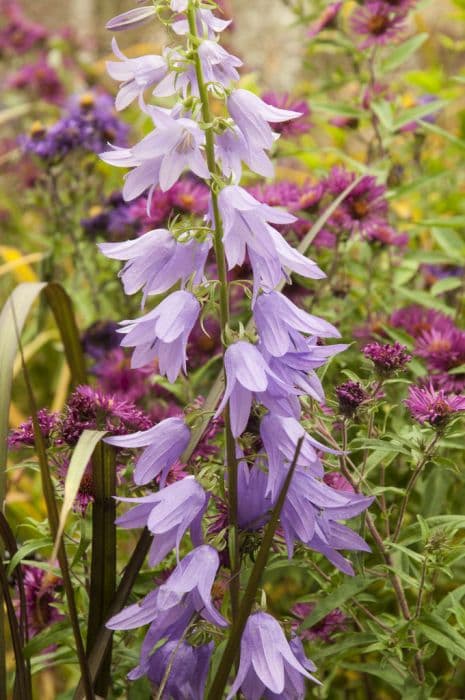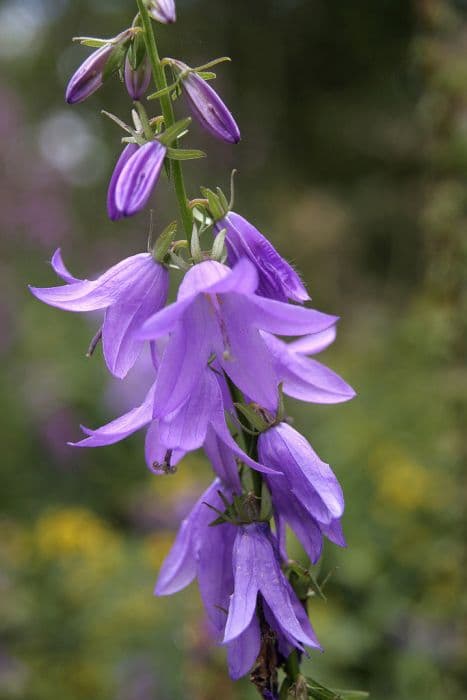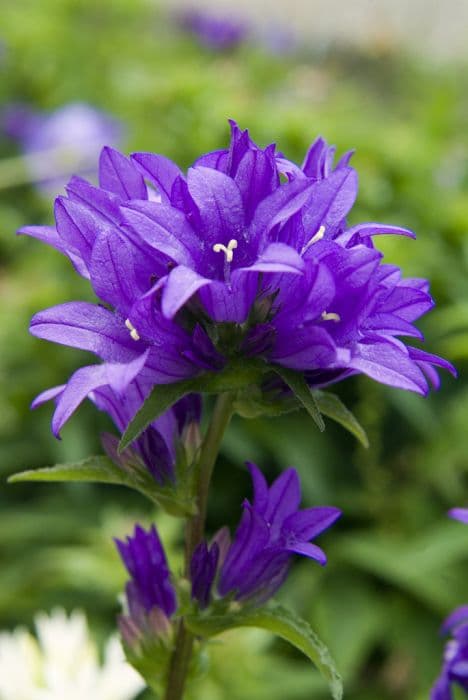Istrian Bellflower Campanula tommasiniana

ABOUT
The plant commonly known as the Italian bellflower has a distinct appearance characterized by its star-shaped, violet-blue flowers that hang in clusters. Its foliage is comprised of narrow, lance-shaped leaves that are mid-green in color, creating a lush backdrop for the striking blooms. The plant often has a cascading habit with stems that seem to spill gracefully over the edges of containers or over rocks and walls when planted in landscape situations. The Italian bellflower's blossoms are notable for their bell-like shape and their tendency to open widely, making the stamens within clearly visible. These flowers are a favorite for attracting pollinators like bees and butterflies to the garden. Overall, the Italian bellflower presents a delicate and charming visual with a profusion of fairy-tale flowers that can add a touch of whimsy to any setting where they are planted.
About this plant
 Names
NamesFamily
Campanulaceae
Synonyms
Istrian Bellflower
Common names
Campanula tommasiniana.
 Toxicity
ToxicityTo humans
The Italian Bellflower is generally not considered toxic to humans. There are no significant reports of poisoning or adverse effects from ingesting this plant. As with any plant, individual allergies or sensitivities could potentially cause mild reactions, but this is not common.
To pets
The Italian Bellflower is also not known to be toxic to pets. Similar to its effects on humans, it does not typically pose a risk of poisoning if pets ingest it. However, it is always wise to prevent pets from eating plants as a precaution, due to potential for individual reactions or gastrointestinal upset.
 Characteristics
CharacteristicsLife cycle
Perennials
Foliage type
Deciduous
Color of leaves
Green
Flower color
Blue
Height
1 feet 3 inches (40 cm)
Spread
1 feet 8 inches (50 cm)
Plant type
Herb
Hardiness zones
5
Native area
Balkans
Benefits
 General Benefits
General Benefits- Aesthetic Appeal: The Bellflower adds visual interest with its showy, bell-shaped flowers and attractive foliage.
- Habitat for Wildlife: It provides nectar for bees and other pollinators, supporting local ecosystems.
- Ease of Care: Being a low-maintenance plant, it is suitable for gardeners of all skill levels.
- Drought Tolerance: The plant can survive with minimal water, making it ideal for xeriscaping or dry gardens.
- Cold Hardiness: It can withstand colder temperatures, which is beneficial for gardens in cooler climates.
- Long Blooming Period: It has a lengthy flowering season that can extend from spring to late summer, offering prolonged enjoyment.
 Medical Properties
Medical PropertiesThis plant is not used for medical purposes.
 Air-purifying Qualities
Air-purifying QualitiesThis plant is not specifically known for air purifying qualities.
 Other Uses
Other Uses- Campanula tommasiniana, commonly known as the Istrian Bellflower, can be used as a natural dye for fabrics, offering hues ranging from blue to violet depending on the mordant used.
- The dried flowers of the Istrian Bellflower can be incorporated into potpourri mixes, adding a touch of delicate fragrance and color to the blend.
- The leaves and flowers of the Istrian Bellflower are sometimes used in decorative crafts, such as pressed flower art, due to their distinct shape and color.
- In homemade cosmetics, the Istrian Bellflower can be used to create natural floral-infused oils for use in soaps, lotions, or bath oils.
- Gardeners may cultivate Istrian Bellflower as a companion plant to attract pollinators like bees and butterflies, which are essential for the pollination of many other garden plants.
- The flower's nectar of the Istrian Bellflower can serve as a food source for beneficial insects, providing a natural way to increase biodiversity in home gardens.
- Istrian Bellflower can be used as a natural indicator plant; certain changes in its flowering or foliage may suggest specific soil conditions or environmental factors.
- In floral arrangements, fresh or dried flowers of the Istrian Bellflower add an ornamental touch to bouquets and can be used as the focal point or as filler among other flowers.
- This plant can play a role in educational settings, where it can be used to teach botany and horticulture students about plant growth habits, flower structures, and taxonomy.
- The Istrian Bellflower can be used in landscaping for ground cover, creating a carpet of green foliage and blue flowers that helps suppress weeds and stabilize soil on slopes or banks.
Interesting Facts
 Feng Shui
Feng ShuiThe Dalmatian Bellflower is not used in Feng Shui practice.
 Zodiac Sign Compitability
Zodiac Sign CompitabilityThe Dalmatian Bellflower is not used in astrology practice.
 Plant Symbolism
Plant Symbolism- Constancy and Perseverance: Campanula tommasiniana, commonly known as the Istrian Bellflower, often symbolizes constancy and perseverance due to its ability to thrive in rocky areas and its steadfast blooming.
- Gratitude: Like many flowers in the Campanula family, the Istrian Bellflower can represent gratitude, making it a suitable gesture of thanks.
- Humility: The bell-shaped flowers which hang down in a humble stance can signify humility in the language of flowers.
- Unwavering Love: Traditionally, bellflowers have been associated with unwavering love due to their reliable flowering and enduring nature.
 Water
WaterThe Serbian bellflower, the common name for Campanula tommasiniana, prefers consistent moisture, so water it when the top inch of soil feels dry to the touch. Typically, this will be about once a week, but this could vary depending on climate and indoor conditions. Use enough water to moisten the soil thoroughly without waterlogging it; this might be around one-half to one gallon every two weeks for an outdoor garden plant or several onzes for a potted plant indoors, depending on the pot size and environmental factors. Avoid overhead watering to reduce the risk of leaf diseases and instead water at the base of the plant. Over winter, reduce watering frequency as the plant requires less moisture during this dormant period.
 Light
LightThe Serbian bellflower thrives in partial sun to light shade, preferring a spot that offers morning sunlight and afternoon shade to protect it from the intense heat of the day. Ideal placement would be an east or north-facing window for indoor plants or a partially shaded area in the garden that receives dappled sunlight throughout the day. Avoid direct, harsh afternoon sun, especially in hotter climates, to prevent scorching the leaves.
 Temperature
TemperatureSerbian bellflowers flourish in moderate to cool temperatures and can generally endure a temperature range from 30°F to 75°F. They prefer a consistently cool environment and can tolerate brief periods of cold down to about 20°F. The ideal temperature range for this plant is between 50°F and 70°F, making it suitable for temperate climates without extreme heat or cold.
 Pruning
PruningPrune the Serbian bellflower to promote healthy growth, maintain its shape, and encourage more abundant flowering. Deadheading spent flowers will stimulate new blooms. Lightly prune the plant back in late winter or early spring before new growth begins to remove any dead or damaged stems and to maintain a compact, bushy form. Pruning can be done as needed throughout the growing season to keep the plant looking tidy.
 Cleaning
CleaningAs needed
 Soil
SoilThe Italian Bellflower thrives in a well-draining soil mix with loamy or sandy consistency that retains moisture without waterlogging. A pH range between 6.0 to 7.5 is optimal. Mix equal parts of garden soil, peat, and perlite or sand for the best results.
 Repotting
RepottingItalian Bellflowers should be repotted once every two to three years to refresh the soil and accommodate root growth. The best time for repotting is in the spring before the onset of the growing season.
 Humidity & Misting
Humidity & MistingItalian Bellflowers prefer moderate to high humidity levels but will tolerate average indoor humidity. Aim for a range of 40% to 60% humidity for optimal growth conditions.
 Suitable locations
Suitable locationsIndoor
Provide bright, indirect light and water moderately.
Outdoor
Plant in partial shade, protect from harsh sun.
Hardiness zone
7-9 USDA
 Life cycle
Life cycleThe life of the Istrian Bellflower (Campanula tommasiniana) begins as a seed, which upon germination in late winter or early spring gives rise to small seedlings. These seedlings develop into rosettes of basal leaves that absorb sunlight and nutrients essential for growth. Throughout spring, the plant grows vertically, producing stems and leaves, and by summer it reaches maturity, with stems bearing beautiful bell-shaped blue or purplish flowers that attract pollinating insects. After pollination, the flowers will produce fruits in the form of capsules containing numerous small seeds. As the growing season ends, the plant may die back, with the seeds overwintering in the soil until next spring, or it may persist as a perennial, with the rosettes remaining semi-dormant during the cold months. In subsequent years, the cycle continues with the germination of new seeds or regrowth from the existing rosettes.
 Propogation
PropogationPropogation time
Spring-Early Summer
Propogation: The most popular method of propagating Campanula tommasiniana, commonly known as the Italian Bellflower, is by division. This is best done in the spring as this is when the plant is actively growing and can recover from the process more easily. To propagate by division, carefully dig up an established clump of the plant and gently separate it into smaller segments, ensuring that each segment has a portion of the roots attached. These segments can then be immediately replanted in well-draining soil, maintaining the same soil level around the roots as the original plant. Water the newly planted divisions thoroughly to help establish them. This method not only helps to propagate new plants but also rejuvenates older clumps that might have become too large or crowded.









